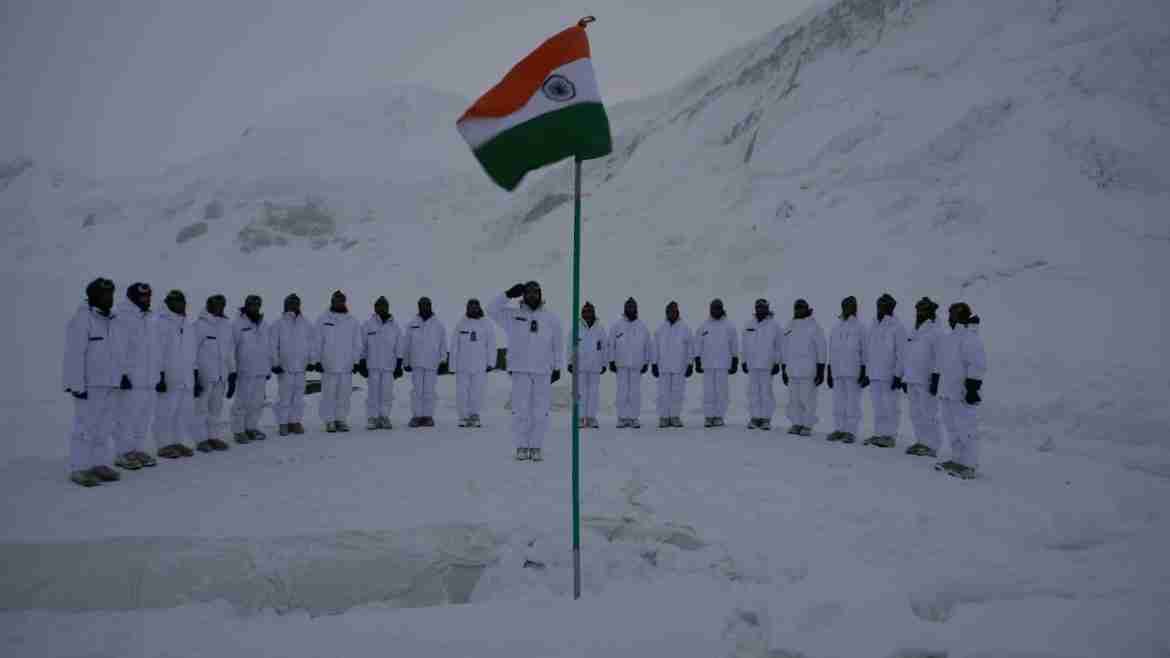
Siachen glacier came into world’s glare in 1984 when there was a sudden news of Indian Army landing troops and occupying Soltoro Ridge, blocking Pakistan Army’s planned offensive codenamed Operation ‘Ababeel’. Siachen glacier has since then been occupied by the Indian Army but comes into news intermittently when any action happens or some high-profile dignitary visits such as the President, the Prime Minister, the Defence Minister or the CDS/COAS.
The Siachen glacier, located in Ladakh Sector of India, is called the highest Battlefield on the earth. The Indian and Pakistan Army troops are deployed on opposite sides, in the Super High Altitudes ranging from 17000 ft – 22,000 ft above mean sea level. The glacier, located on the Indian side is approximately 70 km long flanked by the Soltoro Ridge on the West and the Karakoram Range on the East and extends southwards into the Nubra Valley.
One often remembers the case when Shri George Fernandes as Raksha Mantri personally intervened cutting through the red tape to provide the most essential operationally needed snow scooters to the Army. Many times, questions are raised on the quality of the equipment, clothing and rations being provided to the troops on the glacier. It is certainly costs to the exchequer phenomenally, but the cost of the life and health of the troops that hold the frontline far exceeds that expenditure. Indian Army has lost lives of over 850 troops due to combat and weather, however, the list of those who have lost their health is long.
Siachen hit the headlines in February 2016 when Lance Naik Hanumanthappa of the 19th Battalion of the Madras Regiment, initially survived the massive avalanche and was found after six days of avalanche rescue operations by the Indian Army. He was rescued from 35 feet beneath the packed ice and snow in −60 °C temperature, his CT scan showing evidence of oxygen deprivation to the brain. He had pneumonia in both the lungs along with liver and kidney dysfunction. Nine other personnel at the post, including a junior commissioned officer (JCO) of the same unit died in the incident. His family’s and the country’s celebration was short-lived as he eventually died at the military Hospital in New Delhi due to Multiple Organ Failure on 11 February 2016.
Historical Background
Siachen glacier is part of the erstwhile princely state of J&K inherited by India through the instrument of accession signed by Maharaja Hari Singh. It is only the gradual militarisation of the POK and the Gilgit-Baltistan area that has caused strategic concerns for India. The Karachi agreement of 1949 and Shimla agreement of 1972, both delineated the boundaries of divided J&K upto map reference NJ 9842, and then stated that the boundary runs north of the glaciers.

Pakistan, interpreted this as the line extending Northeast to the Karakoram (KK) Pass while India considered the line to be running northwards along the watershed making entire Soltoro Ridge, west of the glacier, as part of Indian territory. Pakistan has already gifted 5180 sq kms of Sakshgam Valley that lies North of the Siachen to China in 1963 allowing access and control by the Chinese into this area.
Till late 70s, both India and Pakistan barely carried out any military activity in the area. At this time, it came to the knowledge of Indian Army’s Col Narendra Kumar (nicknamed Bull), who was then the Commandant of HAWS and a renowned mountaineer that Pakistan was guiding foreign expeditions across into the Siachen from the west. An American map being carried by a foreign expedition which Bull Kumar chanced to see confirmed that the boundary alignment up to KK Pass, as claimed by Pakistan, is also being shown in some international maps. Intelligence reports further confirmed that Pakistan militarily was preparing to occupy Siachen in early summers of 1984.
Operation Meghdoot
On 13 April 1984, the Indian Army launched Operation Meghdoot, and in a quick preemptive operation, inducted troops on the Soltoro Ridge. The passes of Sia La and Bilafond La on the Soltoro Ridge were occupied by the Indian Army to thwart the designs of the Pakistan Army which was planning to capture Soltoro using these passes. Gradually, the entire Soltoro Ridge was occupied by the Indian Army extending to the areas referred as the Northern, Central and the Southern glaciers. Pakistan Army had to contend occupying certain areas and establishing military posts opposite but at lower

reaches. More number of military posts came up on both sides causing bloody clashes and grab actions. The famous and gallant action by Major Varinder Singh and Naib-Subedar (later Hony Capt) Bana Singh in capturing the Quaid post (later renamed as Bana Post) for which they were decorated with the VrC and PVC respectively, is one of the many such clashes. The entire 121 km of frontline held by both sides northwards of NJ 9842 on the Soltoro Ridge is called the Actual Ground Position Line (AGPL).
Strategic Concerns
Pakistan has always attempted to usurp the state of J&K by force and continues to make military and diplomatic attempts to project this area as disputed. Pakistan has deliberately facilitated the Chinese to carry out military and economic activity in the area. With the China-Pakistan Economic Corridor (CPEC) in near vicinity, both collaborators are not comfortable with the presence of Indian troops in Ladakh, especially Siachen. Hypothetically speaking, should there be absence of the Indian Army at Daulat Beg Oldie (DBO) / Depsang in the eastern Ladakh and on the Siachen in the west, Pakistan and Chinese troops could marry up at the Karakoram, threatening the Nubra and the Shyok Valleys. This would ultimately make Turtok, (southwest of NJ 9842) and large parts of Eastern Ladakh untenable for India. Some experts may differ on the grounds that it would be extremely uncongenial for the adversaries to hold ground for protracted periods of time. However, in an extreme case, such an action would make it possible for the two adversaries to get a foothold on the Ladakh ranges, threatening Leh and the Indus Valley. Even though a tall order, any gradual build up would make a case for Ladakh region to be an objective of two-front militarily action by China and Pakistan – an attempt to control the waters of Indus River. I would like to add that even though such a scenario would be suicidal and cost prohibitive for both China or Pakistan, but given that irrationality has been the virtue of our adversaries, such misadventures could be attempted if India gave any opportunity.
Question of Demilitarisation
On the question of demilitarisation of the glacier, the issue first needs to be understood whether the AGPL is contested or not? The answer is; both sides of the glacier are held by opposing forces and any retrograde move by India would attract Pakistan to move forward and occupy vacated areas. Pakistan Army, desperate to establish its credibility in the eyes of their own people would sell this as military victory not only internally but also to showcase India in poor light. They would be supported, encouraged and certainly funded by the Chinese to maintain presence in these areas. The genesis of occupation of Soltoro ridge in 1984 was basically to deny the Siachen to Pakistan. Nothing has changed since then, and if it has, it changed only for the worse considering the Chinese are making salami slice advances towards Ladakh.
In a hypothetical scenario, even if Pakistan and India were to sign an agreement recognising the AGPL, it would be naive for India to expect Pakistan to respect it. Knowing the past precedent, why would India trust Pakistan to adhere to such an agreement? Considering the increasing collusion between Pakistan and China against India and the ongoing Chinese belligerence on the Indian borders, any thoughts or discussions on Siachen demilitarisation would be disastrous. Pakistan and China are more aggressive and more coordinated currently than any time before and have commonality of interests in Gilgit-Baltistan, through which China has built its strategic CPEC giving them access not only to Gwadar port, but also to Afghanistan.
Piece of Crown on India’s Map
The Indian map shows J&K and Ladakh region as the crown of India. It is an unfortunate reality that two sides of the crown, Gilgit-Baltistan in the west and the Aksai chin in the East are both under occupation of our adversaries. It is only the Siachen glacier which holds out as the piece of India’s crown where the bravest of the brave Indian troops have dared to withstand the vagaries of nature and combat for almost 38 years. Indian Army is spending phenomenal budget on maintaining the Siachen glacier, the weather casualties have been heavy too. However, the experience of Indian troops is unparalleled in the world considering that Indian Army occupies higher reaches of the Soltoro and dominating the Pakistani posts located at lower reaches. If Indian Military prides itself on its readiness to defeat any adversary in super high altitudes it is due to the experience and training of our combat soldiers, pilots and logisticians on the Siachen and Ladakh. India is a proud victor of the highest battlefield on the planet.



